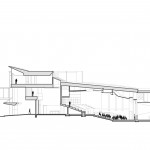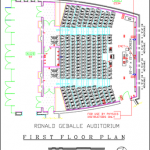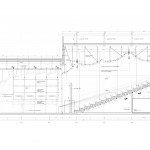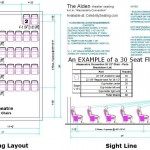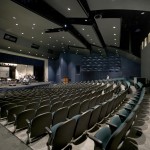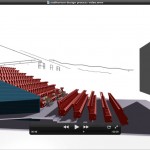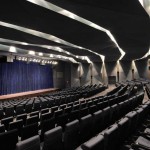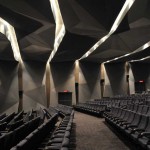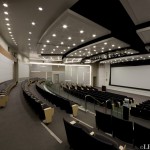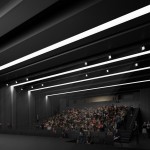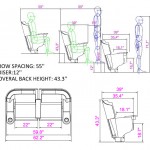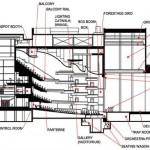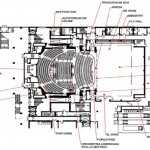Theatre Glossary

Theatre: A place which houses an auditorium and a stage.
Lobby: The room or space between front entrance up to the point where tickets are surrendered.
Foyer: The space or room behind auditorium, between lobby and the seats. The foyer does not have seats.
Loges: A balcony of less than seven rows of seats. In an exceptionally large balcony, the loges would be the extreme front row of seats provided there are less than seven and in front of a cross-aisle.
Auditorium/House: The large room where the audience is seated. Stage personnel refer to this as the House.
Beam: Location of lighting in the auditorium ceiling for illuminating the fore-stage and front part of the stage proper. Sometimes referred to as the Beam position.
Proscenium Wall: Structural wall separating the auditorium from the stage.
Proscenium Arch: Opening through which audience views the performance. Also known as Proscenium Opening. When the word proscenium is used alone, it means the Proscenium Arch.
Proscenium Line: Imaginary line where place of the proscenium intersects the stage floor. For accuracy, this is aligned with the stage side of the proscenium columns.
Stage: The area where actors perform but includes the side and rear areas for handling equipment.
Stage Glossary

Apron: The usually curved area of the stage closest to the audience.
Backstage/Offstage: Usually the entire stage area not visible to the audience.
Backdrop: The drop farthest upstage in most settings. Also a large curtain, sometimes with a picture or design.
Curtain Line: The imaginary line across the stage floor which follows the line of the front curtain.
Grand Drape/Main Rag: The front, often decorative, curtain of a stage.
Cyclorama (usually just “cyc”) : A large, usually white, curtain that is lit to create setting and masks the back of the stage behind the set.
Wings: The areas to the left and right of the stage out of view to the audience. A part of the backstage area.
Legs: Narrow curtains in the wings to mask the backstage areas.
Trap: An opening in the stage floor for actors to pass through to make entrances and exits.
Clear the Stage: A direction given to all dancers to leave the stage area prior to the beginning of a play.
Places: The direction for all dancers to go to their proper position and be ready for the beginning of a play or scene.
Run Through: An uninterrupted rehearsal of a scene, act, or the entire choreography. Typically a run-through does not contain many of the technical aspects of a performance, and is primarily used to assist performers in learning dialogue and to solidify aspects of blocking.
Bows/Curtain Call: The carefully choreographed appearance of actors on stage after the performance to acknowledge the applause of the audience.
Heads Up!: A term of warning used to call attention to overhead danger.
Stage Manager: Person responsible for the physical set up, actors, and technical cues of a production as it is performed.
Cue: The command given to technical departments to carry out a particular operation. E.g. Fly Cue or Sound Cue. Normally given by stage management, but may be taken directly from the action (i.e. a Visual Cue).
Stand-By: A warning given to dancers and technical staff by stage management that a cue is imminent.
Blocking: precise movement and positioning of dancers on the stage.
Technical Rehearsal: Usually the first time the show is rehearsed in the venue, with lighting, scenery and sound. Costumes are sometimes used where they may cause technical problems (eg Quick changes). Often a very lengthy process. Often abbreviated to the Tech.
Dress Rehearsal: A rehearsal or series of rehearsals in which the ensemble dresses as they will dress at the performance for the audience. The entire performance will be run from beginning to end, exactly as the real performances will be, including pauses for intermissions.
Première: (from the French première, meaning “first”) is the very first performance.
Stage Directions

Backstage: The area of the stage that is not seen by the audience.
Upstage: The area of the stage that is the furthest from the audience.
Downstage: The area of the stage that is the closest to the audience.
Stage Right: The right side of the stage from the dancer’s point of view (facing the audience).
Stage Left: The left side of the stage from the dancer’s point of view (facing the audience).
Center: Center of the stage.
Full Front: Facing the audience.
Full Back: Facing away from the audience.
Cross: Movement from one area of the stage to another.
Technical Elements

Props (Properties): Small hand held items used by dancers.
Decor: Furnishings, properties, draperies, and decorations of setting.
Practical: Scenery that is useable. A door, or window that will open, etc.
Lighting Glossary

Backlight: Light coming from upstage, behind scenery or actors, to sculpt and separate them from the background.
Blackout: Complete absence of stage lighting. Blue working lights backstage should remain on and are not usually under the control of the board, except during a Dead Blackout (DBO), when there is no onstage light. Exit signs and other emergency lighting must remain on at all times.
Color Filter: A sheet of plastic usually composed of a colored resin sandwiched between two clear pieces. The colored filter absorbs all the colors of light except the color of the filter itself.
Cross Fade: Bringing another lighting state up to completely replace the current lighting state. Also applies to sound effects / music.
Downlight: A light from directly above the acting area.
Follow Spot: Usually, a powerful instrument usually fitted with its own dimmer, iris, color magazine and shutters mounted in or above the auditorium, used with an operator so that the light beam can be moved around the stage to follow an actor.
Gobo: A thin metal plate etched to produce a design which can then be projected by a profile spotlight (E.g. Foliage, Windows).
House Lights: The auditorium lighting which is commonly faded out when the performance starts.
Light Curtain: A lighting effect which, when an area is diffused with smoke, produces a wall of light.
Projection:
1) Slides are used to project still archive images or textures.
2) Lighting effects: Moving cloud / rain / fire effects can be achieved using a powerful lantern known as an effects projector with a motorized glass disc painted with the required effect.
3) Gobos: See Gobo.
5) Video: Video projection is now being used to bring television pictures to the large screen. Images can be front projected or back projected depending on the amount of space and the effect required. For example, if dancers are required to walk in front of the screen and not have the image appearing on them, back projection is the only answer.
Smoke Machine: Electrically powered unit which produces clouds of white non-toxic fog (available in different flavors/smells) by the vaporization of mineral oil. Specially designed for theatre & film use.
Dry Ice: Frozen solid carbon dioxide (CO2) which produces clouds of steam-loaded CO2 gas forming a low-lying mist or fog when dropped into boiling water.
Snap: A lighting or sound cue with no fade time – the cue happens instantly.
Spotlight: General term for any lantern with a lens system.
Strobe: Device giving a fast series of very short intense light flashes which can have the effect of making action appear intermittent. Because strobe lighting can trigger an epileptic attack in sufferers, the use of a strobe must be communicated to the audience before the performance begins.

GLOSSARY OF THEATER TERMS
Compliments of The Laguna Playhouse
Act: Apart from being what actors do on stage, the term also denotes a division in the performance of a play. Each act may also have several scenes. Nowadays fulllength plays typically have two or three acts. Often, though not invariably, Here is an intermission between the acts.
Actor: A performer in a play. “Actress,” the grammatically correct female form of the word, is little used in the theatre world today although it is still sometimes used in film and television.
Actors Equity Association (AEA): The professional union for actors and stage managers. The union negotiates contracts regulating pay scales and working conditions with Broadway producers and professional regional theaters.
Ad lib: Short for the Latin ad libitum meaning “freely.” In the theatre to ad lib means to improvise lines—though the audience generally shouldn’t know it’s happening unless an actor is responding spontaneously to a comment picked up from the audience. Of course, actors may simply ad lib because they’ve forgotten their lines. Even the most experienced actors occasionally have mental blanks—like the rest of us. That’s when they get a prompt.
Antagonist: Antagonists are present in almost every play. They oppose what the main hero, or protagonist is trying to accomplish.
Artistic Director: This is the person who, in a nonprofit professional theatre, chooses the plays and generally the people—director, designer, actors—who will bring the plays to life on stage. The artistic director also carries out the creative mission of the theatre, oversees the artistic quality of the productions and may also direct particular shows.
Auditorium: Strictly it’s an enclosed space in which an audience gathers to hear a performance, so it’s more commonly applied to concert halls. Generally, in the theatre, the auditorium is referred to as the house—thus the expression, much loved by theatre managers everywhere—“full house.”
Balcony: Strictly speaking, this is the second tier of seating in a theatre, elevated and protruding over the back rows of orchestra or mainlevel seating.
Backdrop: A large drapery of painted canvas that provides the rear or upstage masking of a set.
Backstage: The area behind and around the stage that it is unseen by the audience. Some plays, such as Michael Frayn’s farce, Noises Off, and Ronald Harwood’s poignant drama, The Dresser, actually portray life backstage.
Batten: A tubular metal bar, sometimes known as a pipe, to or from which overhead lighting instruments can respectively be attached or hung.
Blackout: A theatrical blackout—as opposed to a power failure—is a sudden darkening of the stage.
A slow darkening is described as “fade to black.”
Blocking: These are the stage movements and positions that the director works out with the actors in rehearsal for dramatic effect—and so they won’t bump into each. The stage manager makes a careful note of blocking directions for later reference.
Break a leg: A friendly, customary encouragement offered to performers prior to a show. It may sound harsh but the expression is said to derive from the idea of a performer, having left the stage,
being called back from behind the legs for an encore.
Booth: An enclosed, windowed area, usually at the back of the auditorium, used for technical control purposes. Sometimes there is a separate booth for sound and lighting control. The stage manager may also operate from a booth rather than from backstage.
Border: A narrow, horizontal masking piece above the stage. Borders serve to hide the lighting rig and scenery—in theatres that can “fly” or raise scenery out of sight. Borders also define the upper limit of the audience’s stage view. See also, teaser.
Box set: A scenic design that includes three walls and sometimes a ceiling, usually to give a very realistic visual effect. It tends to emphasize the notion of a fourth invisible wall, the one at the front through which the audience observes the action.
Broadway: The famous theatre district of midtown Manhattan in which 32 theaters are located.
Call: This is a notification to cast and crew of a rehearsal or performance. It’s also used to describe the countdown to a performance provided by stage management.
Cast: The complement of actors in a play.
Catwalk: Narrow bridges above the stage from which scenery and lighting equipment can be handled. Some theatres also have lighting catwalks above the seating area.
Comedy: This term describes a play that is light in tone and designed to amuse. The ancient Greeks are credited with inventing comedies as a way to comment satirically on domestic situations.
Costume: What an actor wears to evoke the appearance of a particular character. Costumes may be realistic or stylized. They may be “period”—appropriate to the historical setting of the play—or deliberately modern in look, even when the play is set in a past era.
Crew: The team of theatre workers—often the unsung heroes—who take care of the physical aspects of a production at each performance.
Cue: A prearranged sign that indicates to a performer, crew member or stage technician that it is time to proceed to the next line or action. Actors also listen for cues in the text so that they know when it’s time to say or do something.
Commercial theatre: A businessoriented approach to theatrical production in which the objective is to make a profit for the backers. Commercial productions and nonprofit theatre productions are neither inherently better nor worse than each other. Sometimes a play that has begun life in the nonprofit environment may go on to have a commercial run and vice versa. Commercial theatre,
however, tends to avoid artistically risky and adventurous fare.
Cove: A position in the auditorium where stage lighting can be placed and hidden from the audience.
Curtain call: What happens at the end of the play—even if there isn’t an actual curtain to signal the end—when the actors acknowledge the audience’s applause.
Dark: We say the theatre, or house, is “dark” when it’s closed to the public, as between productions or on nonperformance days.
Denouement: A concluding scene in a play where the drama of the action is resolved—happily or otherwise. Some playwrights deliberately avoid a traditional denouement, leaving the drama effectively openended.
Designer: This a person who designs sets and/or costumes for a play. Also, the person responsible for illuminating a production is often called the lighting designer.
Dialogue: Conversation in a play.
Director: The person responsible for interpreting and bringing the text of a play to life on stage. The director also manages the overall artistic unity of the production.
Downstage: The front of the stage closest to the audience.
Drop: A large piece of fabric hung down onto the stage floor.
Dry Ice: Frozen carbon dioxide used to produce stage mist. Dry ice is so cold that when a lump of the stuff is lowered into boiling water it produces clouds of dense, heavy steam that can be pumped on stage to produce a lowlying mist. If a more generalized misty effect is required dry ice is replaced or supplemented by smoke generated by burning a special oilbased substance
Exposition: The part of a play that fills in things that have already happened so you can make sense of who’s who and why they’re doing whatever. Sometimes playwrights use actual narrators to do this by addressing the audience directly. Other times the exposition is cleverly woven into the opening dialogue.
Flat: A flat piece of painted scenery often consisting of a wooden frame covered with stretched fabric, usually canvas.
Footlights: Once a common feature in theatres, this row of lights across the front edge of the stage is rarely employed today. Even so, you may still hear someone say of an actor: “She really projects across the footlights.”
Front of House: This usually refers to the public areas of the theatre but strictly includes everything in front of the proscenium. A frontofhouse manager oversees staff members who work in this area.
Ghost light: A light left on when a theatre is closed for the night.
Gobo: An etched plate, usually metal, put in front of a spotlight so that a pattern is cast on stage. Gobos can be used in all kinds of ways, for example, to imitate the effect of light filtered through foliage or to create the effect of a neon sign. A gobo can be placed in a rotating holder to create a dynamic effect such as the light reflected from rippling water.
Green room: A room in the theater—rarely painted green—where the actors and crew can relax or receive instructions. The term may come from ancient Greek theatre where actors would stretch out on the lawn before stepping onstage.
Grip: A colloquial term for a stagehand.
Hamming: This describes flagrant overacting—something you’ll never see at The Laguna
Playhouse!
House: The place where the audience sits to enjoy the performance on stage.
House lights: The lights in the house or auditorium. Dimming of the house lights customarily signals the start of a performance.
Intermission: A designated break in a play. In cases where there is no intermission you will be warned in advance.
Legs: Vertical curtains or flats used to hide the wings from view and frame the audience’s view of the stage.
Lines: What actors learn and speak on stage. The word is also used technically to refer to the counter weighted ropes or wires that may be used to lower scenery.
Load In: This is what happens when the set and props are moved into the theatre. The reverse is a“load out.” Managing Director: The person—sometimes titled general manager or executive director—who runs the business and general nonartistic operations of a nonprofit theatre. This important figure also has some of the duties provided by a producer in commercial theatre since he or she is in charge raising the money to make the artistic director’s vision come to fruition. At The Laguna Playhouse this person is Executive Director Richard Stein.
Masking: Basically this is scenery or other visible material designed to hide backstage stuff the audience is not supposed to see, such as the wings or the back wall.
Monologue: A lengthy speech by a single character delivered to other
characters in a play; not to be confused with a soliloquy.
OffBroadway: Professional Manhattan theatres not located on Broadway’s
famous “Great White Way”. Generally, OffBroadway productions are
smaller in scale and tend to be more experimental, although OffBroadway
shows that turn into big hits are often “transferred” to Broadway
itself.
OffoffBroadway: Really small, often subsidized theatres in unusual
New York City venues that tend to focus on experimental plays.
Offstage: Technically this refers to all stage areas outside the visible acting area.
Onstage: The acting area of the stage floor.
Orchestra: In its ordinary sense this refers to a group of musicians but the term is also used in the theatre to refer to the seating area immediately behind the orchestra pit—even when there is no pit! By the way, if you’re buying a ticket in a British theatre, forget about the orchestra seats. Ask for a seat in “the stalls”.
Orchestra Pit: This is where an orchestra will usually be placed in a musical production. It generally extends across the breadth of the stage and is called a pit because it’s at a lower elevation so that the musicians do not block the audience’s view. The floor of most modern orchestra pits can be elevated so that when not being used for live music the area can accommodate more rows of seats.
Parterre: From Old French, this literally means “on the ground.” Definitions vary but often it has been used to describe seating towards the rear of the main level, often under the balcony.
Playwright: The person who writes the play. In the case of living playwrights they sometimes direct and may in rare cases even act in their own work.
Prompt: This is what actors get if they forget their lines. Some theatres have fulltime prompters standing by in the wings. Props: Objects on the stage such as furniture that are not part of the actual scenery. Hand props are objects the actors actually handle such as swords, books and cups.
Proscenium: Sometimes known as the “proscenium arch”, this is an opening through the wall separating the stage from the auditorium. It is often ornately decorated to frame the stage. Modern theatre design, in order to allow greater flexibility and deemphasize the division between stage and audience, tends to avoid including a traditional proscenium.
Protagonist: The character who generates the main action of the story.
Rake: This is the slope of the floor of an auditorium or, where utilized, a stage.
Repertory: This term is now used in a variety of ways. All the plays in a season could be called the repertory. Strictly speaking, when we speak of a “repertory theatre” we mean a company of actors performing different roles in a number of concurrently rotating productions.
Run: In the theatre this refers to the total number of performances or length of time a play is being presented. Most plays at The Laguna Playhouse have a onemonth run.
Scenery: The various flats, drops, etc. that are used to create a particular visual setting for a play.
Scrim: This is a gauzy translucent curtain. The scrim may be plain or painted. When light is thrown on the front of a scrim it becomes opaque but if objects behind it are more brightly lit they will become visible. Balancing lighting levels behind and in front of the scrim is an effective way to create interesting visual effects and transitions.
Set: The scenery for a scene or entire production. In the latter case it is often known as a “unit set”
when designed to serve as several different settings with only minor changes between scenes or
acts.
Sight lines: These are the imaginary lines drawn from the farthest seats to the stage. This
determines where the action is placed onstage for optimum viewing. A welldesigned theatre has
good sight lines, meaning almost all seats—as at The Laguna Playhouse—have a great view of the
stage.
Soliloquy: This is a playwright’s device for letting us know what’s on a character’s mind. It’s as if
we’re listening in on the character’s thoughts. A soliloquy is different from a monologue in that it’s not
being consciously directed at the audience. Shakespeare wrote one of theatre’s most famous
soliloquies for Hamlet: “To be, or not to be?” And, of course, Hamlet never could quite make up his
mind.
Smoke: Stage smoke is produced by the vaporization of various oilbased substances. Smoke machines or “foggers” direct this nontoxic material on stage to create various effects.
Stage Left/Right: These directions are from the actors’ perspective looking out towards the audience. So, if the stage direction calls for an actor to “exit stage left” it will be the opposite of the way the audience sees it.
Stage makeup: This is a makeup used to shape and define actors’ facial feature as seen on stage. It can be simple—just a little lipstick and eye shadow—or elaborate, involving such things as false chins and noses.
Stage Manager: This is a very important person who gives instructions or “calls” for just about everything that happens on stage. Because directors usually leave soon after a show has opened, stage managers are also responsible for seeing that a production continues to be performed just the way the director wanted. Stage managers lurk unseen by the audience, either just out of sight in one the wings or in a booth at the back of the house. Depending on the arrangement of a theatre and scale of a production there may also be one or two assistant stage managers.
Strike: Although unionized actors and crew have been known to strike, in the theatre this term is generally used to describe the process of disassembling the set when a production closes.
Tabs: This term comes from “tableaux” curtains, drawn back and up to reveal a scene. Nowadays the term describes various curtains hung on stage. In theatres that routinely have curtains that hide the stage when the performance is not in progress, these are called the “house tabs.”
Teaser: This a type of border used in combination with tormentors to frame the audience’s window onto the stage.
Tormentors: These are narrow, adjustable masking flats on each side of the stage opening. Combined with a teaser they can be used to frame the audience’s window onto the stage.
Trap: This is an opening in the stage floor. In cases where the design and construction of a stage permits it, a trap can be used for all kinds of effects. Generally, however, traps are rarely used in contemporary drama.
Trap Room: The space below the stage used for accessing traps. It is useful as a storage area.
Upstage: This is the area toward the back of the stage, away from the front edge. The term is also used to describe what happens when a performer tries to draw an audience’s attention away from another performer. Wings: The areas to either side of the stage that the audience does not normally see.

